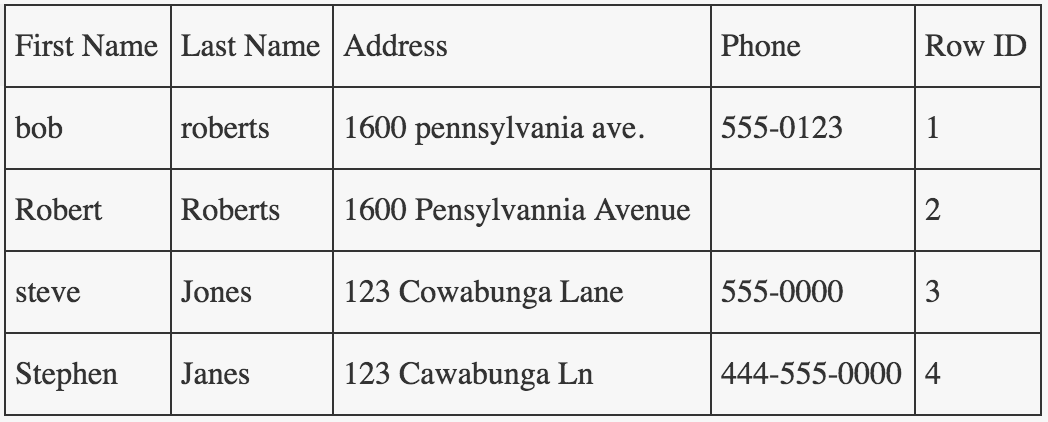While going through the examples of the Dedupe library in Python which is used for records deduplication, I found out that it creates a Cluster Id column in the output file, which according to the documentation indicates which records refer to each other. Athough I am not able to find out any relation between the Cluster Id and how is this helping in finding duplicate records. If anyone has an insight into this, please explain this to me. This is the code for deduplication.
# This can run either as a python2 or python3 code
from future.builtins import next
import os
import csv
import re
import logging
import optparse
import dedupe
from unidecode import unidecode
input_file = 'data/csv_example_input_with_true_ids.csv'
output_file = 'data/csv_example_output1.csv'
settings_file = 'data/csv_example_learned_settings'
training_file = 'data/csv_example_training.json'
# Clean or process the data
def preProcess(column):
try:
column = column.decode('utf-8')
except AttributeError:
pass
column = unidecode(column)
column = re.sub(' +', ' ', column)
column = re.sub('\n', ' ', column)
column = column.strip().strip('"').strip("'").lower().strip()
if not column:
column = None
return column
# Read in the data from CSV file:
def readData(filename):
data_d = {}
with open(filename) as f:
reader = csv.DictReader(f)
for row in reader:
clean_row = [(k, preProcess(v)) for (k, v) in row.items()]
row_id = int(row['Id'])
data_d[row_id] = dict(clean_row)
return data_d
print('importing data ...')
data_d = readData(input_file)
if os.path.exists(settings_file):
print('reading from', settings_file)
with open(settings_file, 'rb') as f:
deduper = dedupe.StaticDedupe(f)
else:
fields = [
{'field' : 'Site name', 'type': 'String'},
{'field' : 'Address', 'type': 'String'},
{'field' : 'Zip', 'type': 'Exact', 'has missing' : True},
{'field' : 'Phone', 'type': 'String', 'has missing' : True},
]
deduper = dedupe.Dedupe(fields)
deduper.sample(data_d, 15000)
if os.path.exists(training_file):
print('reading labeled examples from ', training_file)
with open(training_file, 'rb') as f:
deduper.readTraining(f)
print('starting active labeling...')
dedupe.consoleLabel(deduper)
deduper.train()
with open(training_file, 'w') as tf:
deduper.writeTraining(tf)
with open(settings_file, 'wb') as sf:
deduper.writeSettings(sf)
threshold = deduper.threshold(data_d, recall_weight=1)
print('clustering...')
clustered_dupes = deduper.match(data_d, threshold)
print('# duplicate sets', len(clustered_dupes))
cluster_membership = {}
cluster_id = 0
for (cluster_id, cluster) in enumerate(clustered_dupes):
id_set, scores = cluster
cluster_d = [data_d[c] for c in id_set]
canonical_rep = dedupe.canonicalize(cluster_d)
for record_id, score in zip(id_set, scores):
cluster_membership[record_id] = {
"cluster id" : cluster_id,
"canonical representation" : canonical_rep,
"confidence": score
}
singleton_id = cluster_id + 1
with open(output_file, 'w') as f_output, open(input_file) as f_input:
writer = csv.writer(f_output)
reader = csv.reader(f_input)
heading_row = next(reader)
heading_row.insert(0, 'confidence_score')
heading_row.insert(0, 'Cluster ID')
canonical_keys = canonical_rep.keys()
for key in canonical_keys:
heading_row.append('canonical_' + key)
writer.writerow(heading_row)
for row in reader:
row_id = int(row[0])
if row_id in cluster_membership:
cluster_id = cluster_membership[row_id]["cluster id"]
canonical_rep = cluster_membership[row_id]["canonical representation"]
row.insert(0, cluster_membership[row_id]['confidence'])
row.insert(0, cluster_id)
for key in canonical_keys:
row.append(canonical_rep[key].encode('utf8'))
else:
row.insert(0, None)
row.insert(0, singleton_id)
singleton_id += 1
for key in canonical_keys:
row.append(None)
writer.writerow(row)
Thanks in advance


